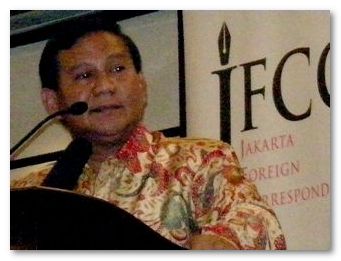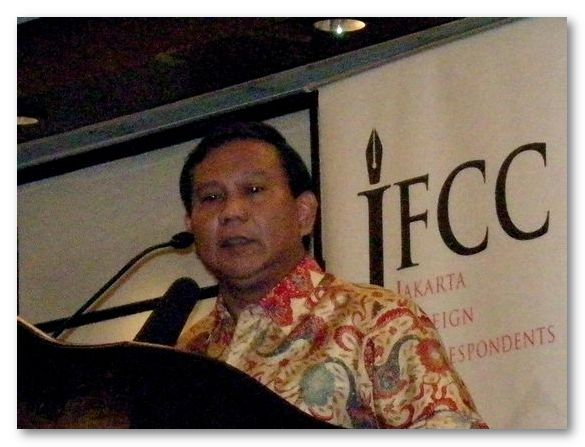Prabowo’s party has deep roots in Indonesian political mythology
Aboeprijadi Santoso
Prabowo dreams of a Greater IndonesiaAboeprijadi Santoso |
Grand designs thrive in times of crisis. They are often a part of reinvigorated nationalism and have resulted in populist, authoritarian regimes. Sometimes, as with Hitler, Stalin, or the Khmer Rouge, they have produced humanitarian disasters. Other times they have fizzled out or ended in debacle.
Indonesia has recently witnessed the revival of such grand designs, that of ‘Indonesia Raya’ or Greater Indonesia. Promoted in this year’s elections by the former military general, Prabowo Subianto, this idea dates back to before even the early years of Indonesian nationalism.
Dreaming of greatness
Indonesia’s history is filled with great hopes and dreams. Some it inherited from the scores of kingdoms in the archipelago. Others were born from the ashes of two great imperial powers. The Dutch dreamed romantically of a Girdle of Emeralds (Gordel van Smaragd) draped along the equator. The Japanese incorporated Indonesia in a vast ‘Greater East Asia Co-Prosperity Sphere’. Both dreams - despite the latter’s much shorter life – had great impacts on the young nation.
The newly born state in the 1940s inherited not just a legacy of colonial oppression, but also a swathe of ideas, both native and modern, that had been debated and nurtured since early in the twentieth century. The Dutch ‘ethical’ spirit from the late nineteenth century inspired the thought of modernisation. At the same time, Japan’s 1905 victory over Russia stimulated a kind of jingoistic euphoria.
Many Indonesian intellectuals in the 1930s saw fascism as a trendy idea. Some considered it a danger that could somehow turn into a ‘new hope’
The pioneering women’s champion R.A. Kartini envisaged the dawning of new hope for an entire people. Young ethnic nationalists discovered they could work together towards one single nation. The lawyer Mohammad Yamin dreamed that this nation might grow beyond the Netherlands Indies - his Yawadwipa Nusantara (Archipelago of Eight) included Peninsular Malaya. The socialist Sutan Sjahrir condemned ‘feudalism’, feared militarism, and worked for a modern democracy. Sukarno spoke of the ‘Golden Bridge’ towards a bright future. Islamists and communists held up their own utopias. Soepomo, a Dutch-educated lawyer who was a key framer of the constitution of 1945, evoked the nation as one great community (Gemeenschap), protected by the State as a benevolent Patron. Villagers, also, seemed eternally to remember the myth of the coming Ratu Adil, ‘the Just Ruler’.
Parindra and the patron state
These were the values the new republic was supposed to bring into being. None had expressed ideas of national greatness as clearly as the medical doctor Soetomo, founder in 1935 of the political party Parindra - Partai Indonesia Raya, the Greater Indonesia Party. This party admired Japan’s revivalist spirit and popularised Hitler’s fascist ideas. Parindra was a split from the movement widely seen as the pioneer of the national awakening, Boedi Oetomo. The spirit of Greater Indonesia was an important asset for the genesis and strengthening of nationhood. But it could also be distorted to provoke anti-democratic emotions.
Soepomo’s idea of the State as Patron was akin to that of Soewardi Soerjaningrat, better known as Ki Hadjar Dewantara, Indonesia’s ‘Father of Education’. Both were Dutch-educated as well as culturally conservative. They were deeply nativist – that is, oriented to Javanese tradition. Both harboured sympathies for Hitler’s leadership style. Many Indonesian intellectuals in the 1930s saw fascism as a trendy idea. Some considered it a danger that could somehow turn into a ‘new hope’. Few stood firmly against it.
Suharto’s generals appropriated Parindra’s and Soepomo’s celebration of the State-as-Great Patron to justify the New Order’s authoritarian rule
Diffuse motifs associated with the idea of Indonesia Raya can be found throughout the post-independent period. Outward-looking and expansive, they sometimes carried a chauvinistic and even megalomaniac spirit. But they were not unchallenged, and indeed they ultimately failed. Sukarno aggrandised his Guided Democracy by trying to create an alliance of Malaya, the Philippines and Indonesia that he called Maphilindo. He saw himself as a champion of all newly independent states, the New Emerging Forces. All went nowhere. Suharto’s New Order, in turn, aggressively expanded the republic only to shamefully end up in the great fiasco of East Timor. He was also badly mistaken when he went to the International Court of Justice with Malaysia in 1996 over the Sipadan-Ligitan islands. His drive to crush Aceh’s rebellion was characterised by the same spirit. His generals appropriated Parindra’s and Soepomo’s celebration of the State-as-Great Patron to justify the New Order’s authoritarian rule.
Renaissance
Back in the colonial period, the Dutch and educated Indonesians often pictured the communities as idyllic, harmonious and backward. This image was attractive to the populist Parindra. Populism in those days presumed a homogenous society, denying the very existence of rich and poor social classes.
Today another, highly spirited rightwing populist political party has emerged. Its name, Gerindra, Gerakan Indonesia Raya, the Greater Indonesia Movement, signifies its fervour for revitalising the greatness of the nation. Founded on 6 February 2008, the party is linked to ex-general Prabowo Subianto, aged 58, who is also President Suharto’s former son-in-law. Prabowo is a maverick who likes to present himself heroically. Whereas Gerindra’s spiritual predecessors in the 1930s such as Soepomo and Soewardi were strongly oriented to the Dutch and to Europe, Gerindra has a purely local orientation. But it has a rather similar dream. It is a vehicle for “Indonesia’s Renaissance”, Prabowo has said.
Prabowo’s lieutenant in Gerindra is the still-vigorous Sukarnoist Permadi. He calls Prabowo ‘Little Sukarno’. During the recent fracas over ‘cultural items’ allegedly stolen by Malaysia, Permadi aggressively suggested that Indonesia should renew Sukarno’s 1960s ‘Ganyang Malaysia’ (Crush Malaysia) campaign. And Prabowo likes him.
Prabowo’s lieutenant in Gerindra calls Prabowo ‘Little Sukarno’ and suggests that Indonesia should renew Sukarno’s 1960s ‘Crush Malaysia’ campaign
However, the party is not about reviving Sukarno-style leftism. Its core leaders are a group of politicised retired officers whose careers rose under the New Order. Their main ideology is the sacredness of the unitary state and the 1945 constitution. They have denounced the post-New Order constitutional amendments (which were designed to improve protection of human rights). They are also sceptical about the Helsinki peace pact for Aceh. Asked whether he would review the pact, Prabowo replied: “If necessary yes, we’ll see later.”
Paths to power
 |
Prabowo dreams of a Greater IndonesiaAboeprijadi Santoso |
A decade ago Prabowo was quoted as saying there were only three paths to power: Islam, the military and being close to Suharto. He had been close to all three for some time. But by the time the collapse of Suharto’s government and the subsequent reformasi intervened he had alienated too many of those forces to achieve his top ambition. Now he is back. In April’s parliamentary elections his new party reached a remarkable five per cent of the total vote. In the presidential elections of July he was running mate to Sukarno’s daughter, Megawati Sukarnoputri of the nationalist PDIP (Democratic Party of Struggle). They placed second in a three-horse race.
Prabowo adopted a chauvinistic bravado. His campaign appearances co-opted hyper-nationalist symbols, imitating Sukarno’s jargon, body language, and even his safari shirt. ‘Now I’m fighting my last battle,’ he recently said. ‘I want to lay the ground for Indonesia’s Renaissance…We have to return to Indonesia, the true one.’
Besides the red-and-white flag, Gerindra uses the mythical eagle garuda to emphasise its love for the nation and to stimulate proud feelings of unity. Once simply flat, since the New Order the garuda has changed into a three-dimensional symbol that looks bigger and more aggressive.
Prabowo has never referred to his party’s namesake Parindra, but he is undoubtedly aware of its ideas. Like Parindra more than half a century ago, Gerindra places its hope on crisis – even after Prabowo’s defeat in the presidential elections. Nevertheless, Gerindra would do well to remember that Parindra, like other fascist groupings in the Netherlands Indies, did not survive into independence. ii
Aboeprijadi Santoso (‘Tossi’) (aboeprijadi@gmail.com) is Jakarta correspondent for Radio Netherlands Worldwide (http://www.rnw.nl/ ).












